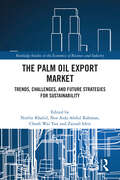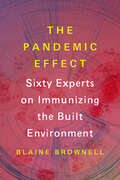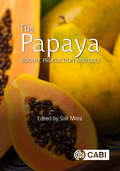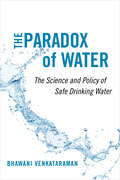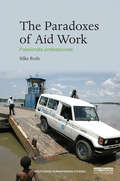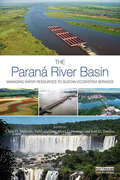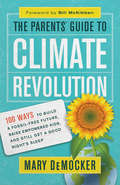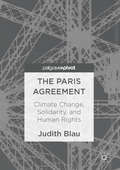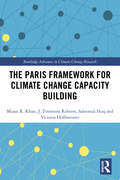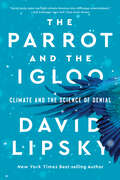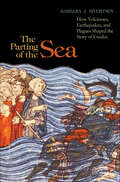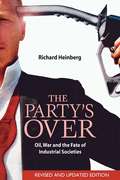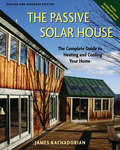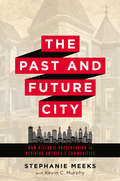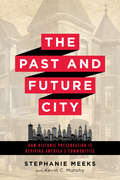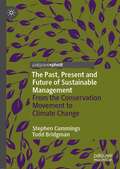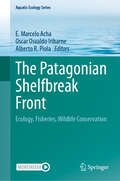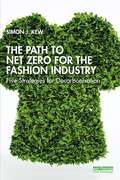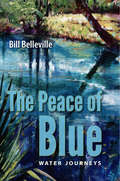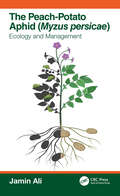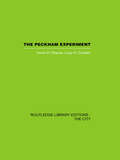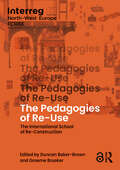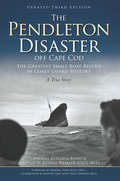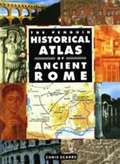- Table View
- List View
The Palm Oil Export Market: Trends, Challenges, and Future Strategies for Sustainability (Routledge Studies in the Economics of Business and Industry)
by Rahman, Nor Aida Abdul Norlin Khalid Cheah Wai Yan Zainab IdrisThis book provides a comprehensive examination of the palm oil export market, including analysis of its current challenges and move towards sustainability.Adopting a multidisciplinary approach, this volume is written by contributors ranging from the fields of economics, engineering, and chemical sciences. Chapters address a wide range of topics including trade market, environmental sustainability, economic dynamics, and future directions to implement nanotechnology and biowaste recycling in the palm oil industry. They synthesize existing research on the palm oil market, and examine the industry’s transformation efforts via technology adoption, biofuel energy research, and its response to new rules and policies from the EU market.This book would appeal greatly to scholars and researchers on international trade, supply chain management, and economic development, especially those in oil palm production and import countries.
The Pandemic Effect: Ninety Experts on Immunizing the Built Environment
by Blaine BrownellIn The Pandemic Effect, 90 leading architects, designers, materials scientists, and health officials reflect on the influence of COVID-19 on buildings and cities—and propose solutions to safeguard the built environment from future pandemics, viruses, and contagious diseases on every scale, from surfaces to society. Safety and sustainability in buildings and cities have taken on new meaning during the COVID -19 pandemic. Buildings became magnifiers of contagion instead of shelters for protection. In this essential resource for both practitioners and students of architecture, interior design, and urban design, 90 of the world's leading experts investigate a variety of approaches to future-proof architecture and buildings against widespread disease. These inoculation strategies are organized into five chapters: "Histories" offers an overview of past pandemics and prior architectural approaches; "Inside / Outside" addresses the roles of building envelopes and mechanical systems in improving indoor environmental quality; "Interventions" consists of contemporary methods for direct prevention and control; "New Strategies" consists of various architectural analyses and proposals for design changes; and "The Public Realm" considers the urban landscape and related social questions. This broad collection of perspectives explores the transformations underway in the built environment—and offers design strategies to limit the severity of subsequent pandemics.
The Papaya: Botany, Production and Uses (Botany, Production and Uses)
by Amalendu Ghosh Robert E Paull Víctor Galán Saúco Edward Evans Rebecca Ford S H Ahmad Christian Alcocer Fredy H Ballen Luis Barboza-Barquero Paul R Campbell A Chan Fure-Chyi Chen Nancy Jung Chen Ting-Chi Cheng Shih Wen Chin Rod Drew Franscisco Espadas Humberto Estrella João Paulo Fabi Gabriela Fuentes Amaranta Giron Julián Cuevas González Eric Guevara Marco V Gutiérrez-Soto Eudaldo Pérez Hernández Jian-Zhi Huang Víctor M Jiménez Chutchamas Kanchana-Udomkan Matiyar Rahaman Khan Chen-Yu Lee Wen-Li Lee Pauziah Muda M Munirah Usana Nantawan Eder Dutra Resende Jorge Manuel Santamaria-Fernandez S K Sharma N I Shukor N E Tajidin Carlos Talavera Lynton L Vawdrey Ziwei ZhouPapaya (Carica papaya) is an important and widely-cultivated tropical fruit, grown in more than 60 countries of the world. Global papaya production has grown significantly over the last few years, mainly as a result of increased production in India. Papaya has become an important agricultural export for developing countries where export revenues of the fruit provide a livelihood for thousands of people, especially in Asia and Latin America. This book includes coverage of recent research developments with the potential to improve crop yields and quality. New research has contributed to our understanding of the crop environment, plant growth and physiology of tree and fruit development with implications for both breeding and cultivation. It looks at how analysis of the papaya genome promises new, faster breeding techniques to improved cultivars and how these and other advances are helping to tackle disease like papaya ring spot viruses and major pests which cause significant losses. Key features include: updated information for sustainable papaya cultivation research developments in tackling the major production and post-harvest problems interdisciplinary and collaborative research With contributions from international experts, the book presents the current state of knowledge concerning the history, physiology, culture and marketing of papaya throughout the world. It is an essential resource for researchers, growers and all those involved in the papaya industry.
The Paradox of Water: The Science and Policy of Safe Drinking Water
by Bhawani VenkataramanWater is a molecular marvel. Its seemingly simple formula—H2O—dictates the properties that make water both essential for life and easily contaminated. Herein lies the paradox of water: we cannot live without it, but it is easily rendered "unsafe." The Paradox of Water explores the intersection of the scientific, social, and policy implications around access to safe drinking water. Drinking water is the smallest fraction of water used by a nation. Yet, the quality of this fraction is what dictates whether a community is healthy, educated, and economically sustained. Bhawani Venkataraman argues that a deeper understanding of the chemical nature of water is crucial to appreciating the challenges around access to safe drinking water. Drawing on recent research and case studies from the US and abroad, this book offers students an understanding of: the processes and oversight needed to ensure the safety of drinking water the role of the precautionary principle in managing drinking water potential solutions for expanding sustainable and equitable access to safe drinking water
The Paradoxes of Aid Work: Passionate Professionals (Routledge Humanitarian Studies)
by Silke RothThis book explores what attracts people to aidwork and to what extent the promises of aidwork are fulfilled. 'Aidland' is a highly complex and heterogeneous context which includes many different occupations, forms of employment and organizations. Analysing the processes that lead to the involvement in development cooperation, emergency relief and human rights work and tracing the pathways into and through Aidland, the book addresses working and living conditions in Aidland, gender relations and inequality among aid personnel and what impact aidwork has on the life-courses of aidworkers. In order to capture the trajectories that lead to Aidland a biographical perspective is employed which reveals that boundary crossing between development cooperation, emergency relief and human rights is not unusual and that considering these fields as separate spheres might overlook important connections. Rich reflexive data is used to theorize about the often contradictory experiences of people working in aid whose careers are shaped by geo-politics, changing priorities of donors and a changing composition of the aid sector. Exploring the life worlds of people working in aid, this book contributes to the emerging sociology and anthropology of aidwork and will be of interest to professionals and researchers in humanitarian and development studies, sociology, anthropology, political science and international relations, international social work and social psychology.
The Paraná River Basin: Managing Water Resources to Sustain Ecosystem Services (Earthscan Series on Major River Basins of the World)
by Chris D. MetcalfeThis book provides insight into the hydrology, ecosystem services and management of water resources in the Paraná River basin, including the importance of water to the socio-economic development of the countries within the watershed. Running through Brazil. Paraguay and Argentina, the Paraná River and its watershed is home to some of South America's major population centers as well as important ecosystems threatened by development. At the same time, the river is a major resource driving the economies of the nations within its boundaries. This volume examines the impacts of environmental degradation, and the tradeoffs between the energy sector and the maintenance of ecosystem services. In particular, it focuses on the threats from development to sensitive ecosystems within the basin and the challenges of transboundary management of water resources. In addition to presenting wider perspectives on water management, the volume specifically covers water infrastructure, aquatic ecosystems, water quality, geomorphological influences and the impact of climate change. Finally, by assessing each country's current status in meeting the Sustainable Development Goals this volume provides a timely analysis as national governments within the basin are becoming increasingly concerned about the sustainability of the freshwater ecosystems within the Paraná River basin. This book will be of great interest to students and scholars of water and natural resource management, environmental policy, sustainable development and Latin American studies. It will also be relevant to water management professionals.
The Parents’ Guide to Climate Revolution: 100 Ways to Build a Fossil-Free Future, Raise Empowered Kids, and Still Get a Good Night’s Sleep
by Bill McKibben Mary DeMocker“Relax,” writes author Mary DeMocker, “this isn’t another light bulb list. It’s not another overwhelming pile of parental ‘to dos’ designed to shrink your family’s carbon footprint through eco-superheroism.” Instead, DeMocker lays out a lively, empowering, and doable blueprint for engaging families in the urgent endeavor of climate revolution. In this book’s brief, action-packed chapters, you’ll learn hundreds of wide-ranging ideas for being part of the revolution — from embracing simplicity parenting, to freeing yourself from dead-end science debates, to teaching kids about the power of creative protest, to changing your lifestyle in ways that deepen family bonds, improve moods, and reduce your impact on the Earth. Engaging and creative, this vital resource is for everyone who wants to act effectively — and empower children to do the same.
The Paris Agreement
by Judith BlauThis book discusses the immediate and severe threat posed by global climate change and the various obstacles that stand in the way of action. Judith Blau presents scientific evidence relevant to The Paris Agreement (COP-21): an international treaty that promises to strengthen the global response to climate change. As she reckons with the dangers of catastrophic planetary heating, Blau discusses the clash between the deeply ingrained American tradition of individualism and the collective action and acknowledgement of intertwined fate needed to address climate change. She acknowledges that America's capitalist bent stands in contrast to the idea of the "commons"--a concept that we need to embrace if climate change is to be mitigated. The volume also explains the foundations of international human rights standards as they relate to climate change. Drawing from guiding principles of human rights and equality, the book concludes hopefully--suggesting that the people of the world can meet the challenge posed by climate change by at once acknowledging shared humanity and celebrating difference.
The Paris Framework for Climate Change Capacity Building (Routledge Advances in Climate Change Research)
by J. Timmons Roberts Saleemul Huq Mizan R Khan Victoria HoffmeisterThe Paris Framework for Climate Change Capacity Building pioneers a new era of climate change governance, performing the foundational job of clarifying what is meant by the often ad-hoc, one-off, uncoordinated, ineffective and unsustainable practices of the past decade described as 'capacity building' to address climate change. As an alternative, this book presents a framework on how to build effective and sustainable capacity systems to meaningfully tackle this long-term problem. Such a reframing of capacity building itself requires means of implementation. The authors combine their decades-long experiences in climate negotiations, developing climate solutions, climate activism and peer-reviewed research to chart a realistic roadmap for the implementation of this alternative framework for capacity building. As a result, this book convincingly makes the case that universities, as the highest and sustainable seats of learning and research in the developing countries, should be the central hub of capacity building there. This will be a valuable resource for students, researchers and policy-makers in the areas of climate change and environmental studies.
The Parrot and the Igloo: Climate And The Science Of Denial
by David LipskyA New York Times Editors’ Choice Named a Best Book of the Year in The New Yorker, Publishers Weekly, Chicago Tribune, and EcoLit Books A USA Today Must-Read Summer Book "David Lipsky spins top-flight climate literature into cliffhanger entertainment." —Zoë Schlanger, New York Times Book Review The New York Times best-selling author explores how “anti-science” became so virulent in American life—through a history of climate denial and its consequences. In 1956, the New York Times prophesied that once global warming really kicked in, we could see parrots in the Antarctic. In 2010, when science deniers had control of the climate story, Senator James Inhofe and his family built an igloo on the Washington Mall and plunked a sign on top: AL GORE'S NEW HOME: HONK IF YOU LOVE CLIMATE CHANGE. In The Parrot and the Igloo, best-selling author David Lipsky tells the astonishing story of how we moved from one extreme (the correct one) to the other. With narrative sweep and a superb eye for character, Lipsky unfolds the dramatic narrative of the long, strange march of climate science. The story begins with a tale of three inventors—Thomas Edison, George Westinghouse, and Nikola Tesla—who made our technological world, not knowing what they had set into motion. Then there are the scientists who sounded the alarm once they identified carbon dioxide as the culprit of our warming planet. And we meet the hucksters, zealots, and crackpots who lied about that science and misled the public in ever more outrageous ways. Lipsky masterfully traces the evolution of climate denial, exposing how it grew out of early efforts to build a network of untruth about products like aspirin and cigarettes. Featuring an indelible cast of heroes and villains, mavericks and swindlers, The Parrot and the Igloo delivers a real-life tragicomedy—one that captures the extraordinary dance of science, money, and the American character.
The Parting of the Sea: How Volcanoes, Earthquakes, and Plagues Shaped the Story of Exodus
by Barbara J. SivertsenFor more than four decades, biblical experts have tried to place the story of Exodus into historical context--without success. What could explain the Nile turning to blood, insects swarming the land, and the sky falling to darkness? Integrating biblical accounts with substantive archaeological evidence, The Parting of the Sea looks at how natural phenomena shaped the stories of Exodus, the Sojourn in the Wilderness, and the Israelite conquest of Canaan. Barbara Sivertsen demonstrates that the Exodus was in fact two separate exoduses both triggered by volcanic eruptions--and provides scientific explanations for the ten plagues and the parting of the Red Sea. Over time, Israelite oral tradition combined these events into the Exodus narrative known today. Skillfully unifying textual and archaeological records with details of ancient geological events, Sivertsen shows how the first exodus followed a 1628 B.C.E Minoan eruption that produced all but one of the first nine plagues. The second exodus followed an eruption of a volcano off the Aegean island of Yali almost two centuries later, creating the tenth plague of darkness and a series of tsunamis that "parted the sea" and drowned the pursuing Egyptian army. Sivertsen's brilliant account explains inconsistencies in the biblical story, fits chronologically with the conquest of Jericho, and confirms that the Israelites were in Canaan before the end of the sixteenth century B.C.E. In examining oral traditions and how these practices absorb and process geological details through storytelling, The Parting of the Sea reveals how powerful historical narratives are transformed into myth.
The Party's Over
by Richard HeinbergThe world is about to run out of cheap oil and change dramatically. Within the next few years, global production will peak. Thereafter, even if industrial societies begin to switch to alternative energy sources, they will have less net energy each year to do all the work essential to the survival of complex societies. We are entering a new era, as different from the industrial era as the latter was from medieval times. In The Party's Over, Richard Heinberg places this momentous transition in historical context, showing how industrialism arose from the harnessing of fossil fuels, how competition to control access to oil shaped the geopolitics of the twentieth century and how contention for dwindling energy resources in the twenty-first century will lead to resource wars in the Middle East, Central Asia and South America. He describes the likely impacts of oil depletion and all of the energy alternatives. Predicting chaos unless the United States--the world's foremost oil consumer--is willing to join with other countries to implement a global program of resource conservation and sharing, he also recommends a "managed collapse" that might make way for a slower-paced, low-energy, sustainable society in the future. More readable than other accounts of this issue, with fuller discussion of the context, social implications and recommendations for personal, community, national and global action, Heinberg's updated book is a riveting wake-up call for human-kind as the oil era winds down, and a critical tool for understanding and influencing current US foreign policy.
The Passive Solar House
by James KachadorianRevised and Expanded Edition-Includes CD-ROM with Custom Design SoftwareFor the past ten years The Passive Solar House has offered proven techniques for building homes that heat and cool themselves, using readily available materials and methods familiar to all building contractors and many do-it-yourself homeowners. True to this innovative, straightforward approach, the new edition of this best-selling guide includes CSOL passive solar design software, making it easier than ever to heat your home with the power of the sun. Since The Passive Solar House was first published, passive solar construction expert James Kachadorian has perfected user-friendly, Windows-compatible software to supplement the design process explained in the book by allowing homeowners/designers to enter the specifications of their design and see how changing a variable will affect its energy efficiency. This is the building book for a world of climbing energy costs. Applicable to diverse regions, climates, budgets, and styles of architecture, Kachadorian's techniques translate the essentials of timeless solar design into practical wisdom for today's solar builders. Profiles of successful passive solar design, construction, and retrofit projects from readers of the first edition provide inspiration to first-time homebuilders and renovators alike.
The Passivhaus Designer’s Manual: A technical guide to low and zero energy buildings
by Christina J. Hopfe Robert S. McLeodPassivhaus is the fastest growing energy performance standard in the world, with almost 50,000 buildings realised to date. Applicable to both domestic and non-domestic building types, the strength of Passivhaus lies in the simplicity of the concept. As European and global energy directives move ever closer towards Zero (fossil) Energy standards, Passivhaus provides a robust ‘fabric first’ approach from which to make the next step. The Passivhaus Designers Manual is the most comprehensive technical guide available to those wishing to design and build Passivhaus and Zero Energy Buildings. As a technical reference for architects, engineers and construction professionals The Passivhaus Designers Manual provides: State of the art guidance for anyone designing or working on a Passivhaus project; In depth information on building services, including high performance ventilation systems and ultra-low energy heating and cooling systems; Holistic design guidance encompassing: daylight design, ecological materials, thermal comfort, indoor air quality and economics; Practical advice on procurement methods, project management and quality assurance; Renewable energy systems suitable for Passivhaus and Zero Energy Buildings; Practical case studies from the UK, USA, and Germany amongst others; Detailed worked examples to show you how it’s done and what to look out for; Expert advice from 20 world renowned Passivhaus designers, architects, building physicists and engineers. Lavishly illustrated with nearly 200 full colour illustrations, and presented by two highly experienced specialists, this is your one-stop shop for comprehensive practical information on Passivhaus and Zero Energy buildings.
The Past and Future City: How Historic Preservation is Reviving America's Communities
by Mr Kevin C. Murphy Ms Stephanie MeeksInThe Past and Future City,Stephanie Meeks, the president of the National Trust for Historic Preservation, describes in detail, and with unique empirical research, the many ways that saving and restoring historic fabric can help a city create thriving neighborhoods, good jobs, and a vibrant economy. She explains the critical importance of preservation for all our communities, the ways the field of historic preservation has evolved to embrace the challenges of the twenty-first century, and the innovative work being done in the preservation space now.This book is for anyone who cares about cities, places, and saving America's diverse stories in a way that will bring us together and help us better understand our past, present, and future.
The Past and Future City: How Historic Preservation is Reviving America's Communities
by Mr Kevin C. Murphy Ms Stephanie MeeksInThe Past and Future City,Stephanie Meeks, the presidof the National Trust for Historic Preservation, describes in detail, and with unique empirical research, the many ways that saving and restoring historic fabric can help a city create thriving neighborhoods, good jobs, and a vibrant economy. She explains the critical importance of preservation for all our communities, the ways the field of historic preservation has evolved to embrace the challenges of the twenty-first century, and the innovative work being done in the preservation space now.This book is for anyone who cares about cities, places, and saving America's diverse stories in a way that will bring us together and help us better understand our past, present, and future.
The Past, Present and Future of Sustainable Management: From the Conservation Movement to Climate Change
by Stephen Cummings Todd BridgmanWe might think sustainable management is a new idea, created in the 1960s by enlightened modern scientists. We might think that it puts us on a new path, beyond what management was originally about. But this is not true. Sustainable management is as old as civilization and was a foundation stone of management science as it was formed in the first decade of the 20th century. Recovering this forgotten past provides deeper roots and greater traction to advance sustainable management in our own times.This book charts a history of sustainable management from premodern times, through the birth of management science as an offshoot of the conservation movement, to the present day. The authors argue that modern tools like Triple Bottom Line reporting and multiple Sustainable Development Goals may be less useful than a return to a more fundamental and holistic view of management.
The Patagonian Shelfbreak Front: Ecology, Fisheries, Wildlife Conservation (Aquatic Ecology Series #13)
by E. Marcelo Acha Oscar Osvaldo Iribarne Alberto R. PiolaThis book provides a compilation of basic information on the topic of the Patagonian Shelfbreak front, but integrally reanalyzes this under modern paradigms. The book provides a synthesis of the ecosystem characteristics, encompassing physical and chemical oceanography, plankton, nekton and benthos communities, fisheries and conservation issues. It provides hypothesis to guide future research, and recommendations for policymakers and stakeholders. Fronts play key roles in marine ecosystems, and shelfbreak fronts are ubiquitous elsewhere in the world ocean, broadening the interest of our proposal. The Patagonian shelfbreak front is a hot spot of marine life, with several associated fisheries and intensive use by marine birds and mammals. This book will contribute to fill the information gap of the Southwestern Atlantic, a region where there is a growing interest in terms of conservation and management actions. Its primary audience are researchers and postgraduate students, being also relevant for conservation scientists and resource managers.
The Path to Net Zero for the Fashion Industry: Five Strategies for Decarbonisation
by Simon J. KewThis book uses a quantitative science-based approach to explain where the greenhouse gas (GHG) emissions emitted by the fashion industry are generated and it explores what strategies can be deployed to achieve Net Zero by 2050. With GHG emissions currently predicted to triple by the middle of the century, the fashion industry is far off course to reach Net Zero, as set out in the Paris Agreement. With misinformation and greenwashing representing an ever-growing barrier to potential solutions, the book aims to demystify the source of GHG emissions from the industry, breaking down in detail their origin, while identifying the steps that can be taken when designing and sourcing new products. Detailing the market drivers and trends in fashion consumption, it argues that change should be guided by science-based quantitative principles. Accessibly written with key insights at the end of each chapter, this book will enable the reader to understand the tactics to tackle decarbonisation, and ultimately outline five main strategies that can be deployed by the fashion and textile industries to align with the Paris Agreement. This book serves as a practical guide for designers, buyers and the fashion industry in general to develop and understand approaches and strategies to reduce energy consumption and the resulting GHG emissions to reach Net Zero.
The Peace of Blue: Water Journeys
by Bill BellevilleThe Earth’s surface is mostly oceans, the human body is approximately 60% water, and the human imagination has been captivated by this life-giving, life-sustaining liquid from time immemorial.According to Carl Hiaasen, Bill Belleville “writes gorgeously and straight from the heart. In The Peace of Blue, the documentarian and nature writer guides you on a lyrical journey to the natural places in Florida and the Caribbean that have been forged and shaped by water. He poetically underscores the vitality of this most essential substance in our lives by showing the many ways in which water-driven landscapes nurture plants, wildlife—and the human spirit.Experience the thrill of traveling to the remote islands of Cuba and to sacred cenotes in the Dominican Republic. Contemplate the shores of Florida’s rivers and lakes and marvel at swamps and seepage slopes. Immerse yourself in the underwater world of clear, fresh springs, and dive into the deep karst caves that are worlds unto themselves.Through adventure and contemplative excursions, Belleville shares his contagious respect—and awe—for the singularity and transcendence of the natural world. We are companions in his search for a distinct sense of place, fellow journeymen in his quest to discover within the watery depths a greater awareness that informs and shapes our common identity.
The Peach Potato Aphid (Myzus persicae): Ecology and Management
by Jamin AliConsidered as economically significant pests with worldwide distribution, aphids feed on hundreds of cultivated and ornamental plants and cause considerable economic loss on a global scale. The peach-potato aphid, Myzus persicae, is one of the most severe model aphid pests and successfully colonizes hundreds of plant species from 40 different families. It is a complex aphid pest known for its high reproductive rate, biotype formation, suppression of plant defenses, and wide range of host plants. This book covers ecological aspects - including life cycle, damage, and host range - which make aphids an economically important pest. A wide range of topics are covered, including ecological aspects of M. persicae; challenges with management approaches; damage; suppression of plant defenses; evolution; the mechanism of resistance against major classes of insecticides; the potential of biological control and natural plant-derived compounds (plant defense elicitors) as an alternative to the use of synthetic chemical insecticides to control M. persicae; and integrated pest management for M. persicae. As the peach-potato aphid is a model aphid pest, studying it helps to develop control strategies against the entire group of aphids. Written for professionals, as well as students, teachers, and researchers in the fields of entomology, ecology, and bioscience, this book is an enriching new addition to its field.
The Peckham Experiment: A study of the living structure of society
by Innes H. Pearse Lucy H. CrockerFirst published in 2006. Routledge is an imprint of Taylor & Francis, an informa company.
The Pedagogies of Re-Use: The International School of Re-Construction
by Graeme Brooker Duncan Baker-BrownThe Pedagogies of Re-Use captures the amazing digital gathering of students, academics, practitioners, and activists that happened at the International School of Re-Construction. Involving over 100 people, from countries as far apart as Brazil, Canada, Ireland, UK, Spain, Germany, Greece, UAE, and China, the participants spent two weeks working in eleven teams to consider architectural propositions responding to the current climate and ecological emergency. This book documents the work of the eleven teams, considering the themes they pursued, the student projects proposed, and the final design ideas developed by each group. Supplemented with images of the work, the book also includes leading academics and professionals who supported the school and contribute their voices to these crucial issues of deconstruction, re-use, and adaptation. It is ideal reading for students and academics looking at the issues created by the climate emergency to which architecture must respond.The Pedagogies of Re-Use is part of an EU ERDF £4.33 million Interreg NWE project entitled ‘Facilitating the Circulation of Reclaimed Building Elements’ (FCRBE), Interreg NWE 739, October 2018– December 2023. Online publication: June 2024, London.The FCRBE project aims to increase the amount of reclaimed building elements in circulation within its territory by +50% (in mass) by 2032.http://www.nweurope.eu/fcrbe
The Pendleton Disaster Off Cape Cod: The Greatest Small Boat Rescue in Coast Guard History, A True Story (Disaster)
by Theresa Mitchell Barbo Captain W. Russell WebsterA first-hand account and fascinating new details of the 1952 rescue of the SS Pendleton, the true story behind the film The Finest Hours.On February 18, 1952, off the coast of Cape Cod, a fierce nor’easter snapped in half two 503-foot oil tankers, the Pendleton and the Fort Mercer. Human grace and grit, leadership and endurance prevail as Theresa Mitchell Barbo and Captain W. Russell Webster (Ret.) recount the historic, heroic rescue of thirty-two merchant mariners from the sinking Pendleton by four young Coast Guardsmen aboard the 36-foot motor lifeboat CG 36500. A foreword by former Commandant Admiral Thad Allen (Ret.) and an essay by Master Chief John “Jack” Downey (Ret.), a veteran of thousands of modern-day small boat rescues, round out the special third edition of this classic work on Coast Guard history.
The Penguin Historical Atlas of Ancient Rome
by Chris ScarreThe Penguin Historical Atlas of Ancient Rome is an introduction to the Roman Empire based on maps.
